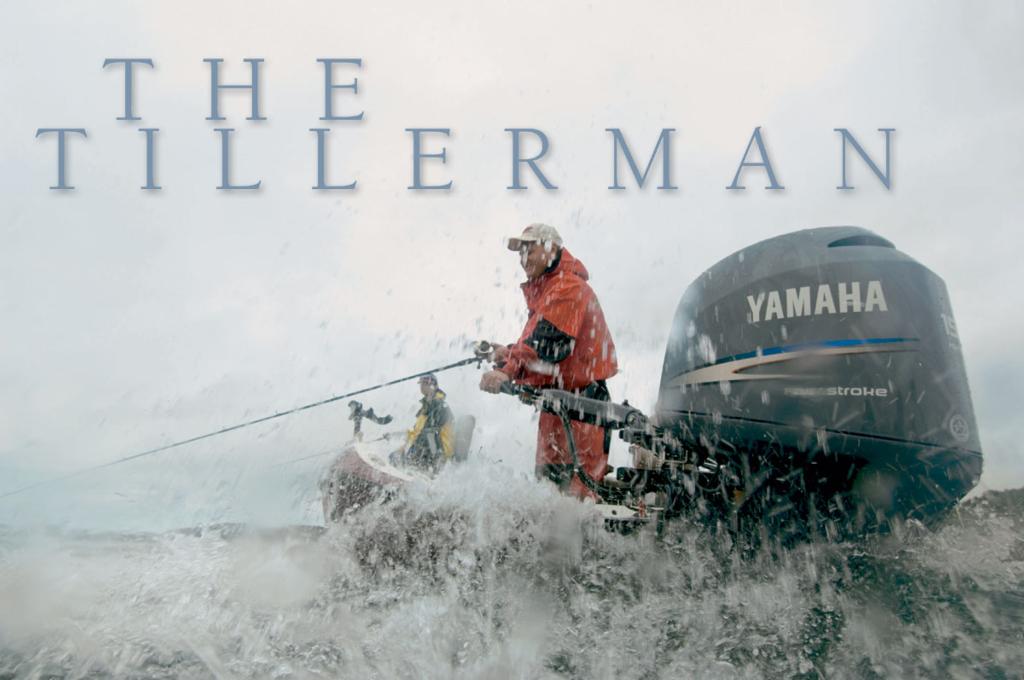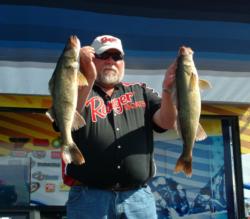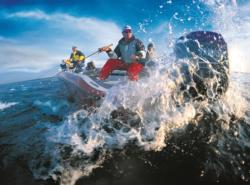The Tillerman
Advantages to a tiller-driven system

Tiller boats were the norm rather than the exception not too many years ago. In the ’70s and early ’80s, tiller boats reigned supreme for most walleye anglers. Then, in the late ’80s, the popularity of walleye tournaments exploded, and preferences for walleye-boat steering changed.
Systems such as the Missouri River in the Dakotas and the Great Lakes fisheries became popular tournament venues. As boats were made larger and safer for big water, higher-horsepower motors became necessary. In many tournaments, long runs to fishing spots were pertinent to success, and these runs were in rough water often as not. Also, tournament anglers didn’t have the luxury of launching their boats at the closest landing like weekend anglers. Tiller boats lost popularity to faster and larger console boats.
Rigged with kicker motors on the back and a high-thrust electric trolling motor on the bow, console boats became much improved fishing platforms for the serious walleye angler. Most anglers felt what they gave up in boat control, they gained back in faster speed and greater mobility. Gradually, recreational anglers latched onto the high-horsepower, center-console concept. Many anglers assumed tiller boats were on the way out. But that’s not necessarily the case.
Tiller comeback
One tournament pro that did not follow the crowd was Pete Harsh of Sauk Centre, Minn. Harsh, with the nickname Mr. Tiller, has won more than $200,000 in FLW Outdoors walleye tournaments alone. He’s also one of the sport’s most recognizable pros, having done well in various other professional circuits. Harsh is a no-nonsense type of guy, and he has some strong opinions on tiller-boat versatility. There are a number of reasons why he has stuck with them all these years.
For starters, Harsh simply likes the extra room and open floor design of his Ranger 620 T. With no consoles in the way, the 620 T offers more floor space for tackle boxes, nets and other equipment that seems to clutter most walleye boats. This makes it much easier to quickly move from front to back on the boat. This is very important when trying to fight and land large fish, particularly during the pressured constraints of a tournament, as consoles have a habit of being in the way when attempting to net the fish.
 Harsh’s main reason for running a tiller boat, though, centers on superior control, especially under adverse conditions. As most experienced anglers can attest, some of the best walleye fishing occurs when the weather is most miserable. One of Harsh’s greatest strengths as an angler is to find fish utilizing small pieces of structure and stubbornly sit on them until the fish decide to feed. To be successful at this tedious process, Harsh needs confidence, patience, a precise presentation and superior boat control. In his many top-10 tournament finishes, Harsh believes his ability to control his presentation and stay on the spots when others couldn’t has made the difference numerous times.
Harsh’s main reason for running a tiller boat, though, centers on superior control, especially under adverse conditions. As most experienced anglers can attest, some of the best walleye fishing occurs when the weather is most miserable. One of Harsh’s greatest strengths as an angler is to find fish utilizing small pieces of structure and stubbornly sit on them until the fish decide to feed. To be successful at this tedious process, Harsh needs confidence, patience, a precise presentation and superior boat control. In his many top-10 tournament finishes, Harsh believes his ability to control his presentation and stay on the spots when others couldn’t has made the difference numerous times.
Tiller accessories
So how does a tiller boat offer better boat control? First, let’s take a look at how Harsh’s Ranger 620 T is rigged. His main motor is a 150-horsepower motor. Also on the transom is a four-stroke, 9.9-horsepower kicker motor and a transom-mount trolling motor. Walleye Master Splash Guards are mounted on the transom to prevent waves from splashing overboard while back-trolling.
The 620 T offers a spacious area for electronics, and Harsh utilizes it by mounting two Lowrance large-screen units, one for a locator and the other for GPS. Each unit serves as a backup for the other in case of a malfunction.
He also has a bow-mount trolling motor that he uses mainly for casting and vertical-jigging presentations. All live-bait rigging, drifting and trolling presentations are done from the stern of the boat. Standard live-bait rigging and bottom-bouncer presentations are done while back-trolling with the trolling motor under calm conditions. The kicker motor is used for forward-trolling applications of crankbaits and spinner rigs.
When it gets too rough for the trolling motor, which often doesn’t take long in the best walleye waters, Harsh switches to his main engine. This is where the tiller boat offers a distinct boat-control advantage over the boat control in a console rig. When the weather gets too rough to use a bow-mount trolling motor, other anglers are limited to either drifting or using a kicker motor to back-troll. Neither is as precise as a large tiller motor backed into the waves, holding a boat steady. Sharp turns and precise speed are easily accomplished with the big motor, even under high winds.
Because of the thrust the main motor offers and the fact that most of your weight is in the transom of the boat, tiller boats will sit on a spot in high winds much easier than a boat operated from the bow. The extra-strong gusts of wind that are the bow-mount trolling-motor’s nemesis are just a minor distraction with the main motor in reverse. Kicker motors don’t allow for as sharp of a turning radius and don’t have the power of the main motor. Harsh also insisted the over-revving of a kicker motor to gain the power necessary to back-troll the boat will spook fish, particularly in shallow water.
 It is important to have a boat with a properly designed hull to track properly. According to Harsh, the Ranger 620 T not only tracks superbly, but also has a slower drift speed than most boats due to the way in sits in the water. This design allows an angler to perform a controlled drift if necessary. By using the main motor at an angle into the wind, it is possible to drift down a breakline and use the motor to move the boat forward or backward to precisely follow the contour. Because the boat tracks true and sits lower in the water than comparable aluminum models, drift speed is slower, even under windy conditions.
It is important to have a boat with a properly designed hull to track properly. According to Harsh, the Ranger 620 T not only tracks superbly, but also has a slower drift speed than most boats due to the way in sits in the water. This design allows an angler to perform a controlled drift if necessary. By using the main motor at an angle into the wind, it is possible to drift down a breakline and use the motor to move the boat forward or backward to precisely follow the contour. Because the boat tracks true and sits lower in the water than comparable aluminum models, drift speed is slower, even under windy conditions.
Drifting too fast is a common error many anglers make, but with a tiller-mounted engine, one can ease the motor in and out of gear to allow a precisely controlled drift at exactly the desired speed.
Tiller speed
Most anglers will concede that a tiller boat offers greater boat control, especially under windy conditions. However, they will point out a tiller boat’s main deficiencies are lack of speed and the torque from holding onto the tiller handle while running. In the past, those were legitimate complaints, but significant improvements have been made to rectify those issues.
A couple years ago, Engine Steer Corporation introduced the Power Tiller Steering system, and quite frankly, tiller boats haven’t been the same since. The Power Tiller Steering system is basically an electro/hydraulic steering system that features a hydraulic pump and cylinder, along with a steering/throttle module. The steering/throttle module replaces the outboard’s throttle.
When the system is operated, the movement of the handle directs the hydraulic cylinder to steer in either direction at whatever speed the operator desires. When no steering movement is desired, the outboard stays hydraulically locked in its position, thereby eliminating torque on the operator’s arm and shoulder. What this means to the driver of a rig with the Power Tiller Steering system is that one can comfortably operate a tiller boat as easily as a wheel boat. It is really easier to use the Power Tiller Steering system than it is to describe it to someone who has never used it before.
George Feder, an avid walleye angler from Nevis, Minn., is one of the system’s biggest fans.
“The Power Tiller Steering system has revolutionized the tiller-boat market,” Feder said. “If it weren’t for this system, I wouldn’t be running a tiller boat any longer. It has given many tiller-boat fans a new lease on running tillers.”
Feder runs a Ranger 620 T with a Yamaha 150-horespower Four-Stroke and reports speeds in excess of 50 mph under optimum running conditions. Fully loaded, the rig still runs in the high 40s.
In rough-water conditions, these tiller boats will often pass many console boats. The reason? Tiller operators sit in the back of the boat and aren’t subjected to as much pounding as a console-boat operator sitting farther ahead in the boat. The Power Tiller Steering system has given fishermen the same advantages of a console boat – namely the ability to run higher-horsepower motors with greater comfort and safety. Meanwhile, they are able to maintain the traditional advantages of the tiller boats, including more floor space and greater boat control under all conditions. Anglers interested in more information on the Power Tiller Steering system can visit enginesteer.com.
The advent of hydraulic steering for tiller boats, along with bigger boats with larger-horsepower motors has led to the return of The Tillerman. Will tillers ever make a comeback and replace console models? Of course not. Console boats have many advantages as well. The choice ultimately boils down to personal preference and fishing style. But there is a growing group of anglers who appreciate the advantages of a tiller boat. They will have pockets of popularity, especially in regions where live-bait rigging is the preferred method of fishing, and the ability to control the boat will make or break the day. As for Pete Harsh, with the nickname Mr. Tiller, it is highly unlikely he will ever run a boat with a steering wheel.